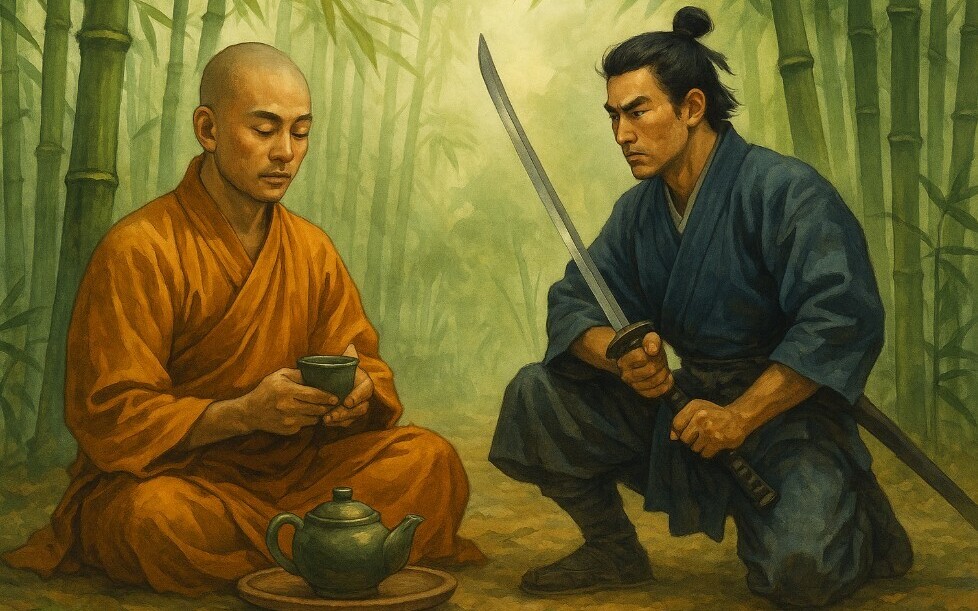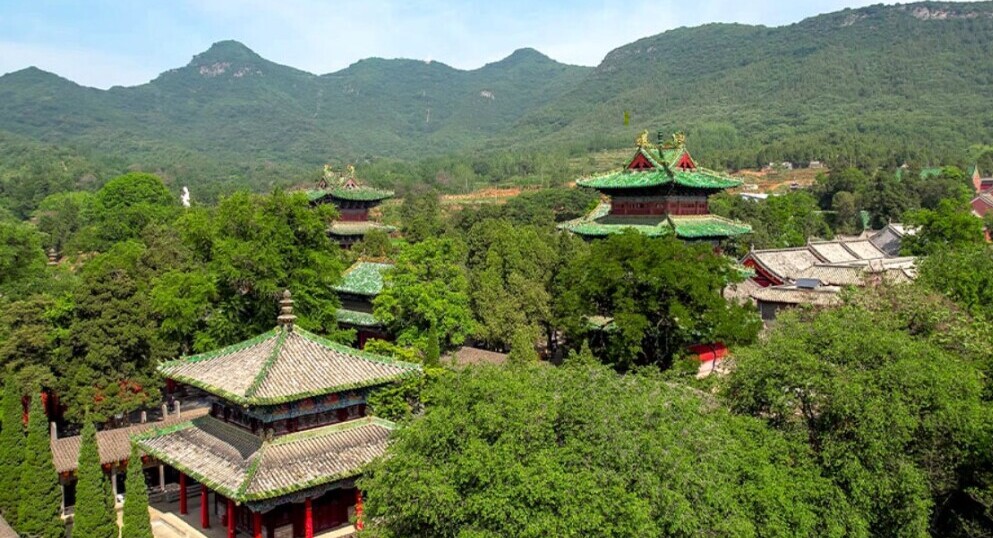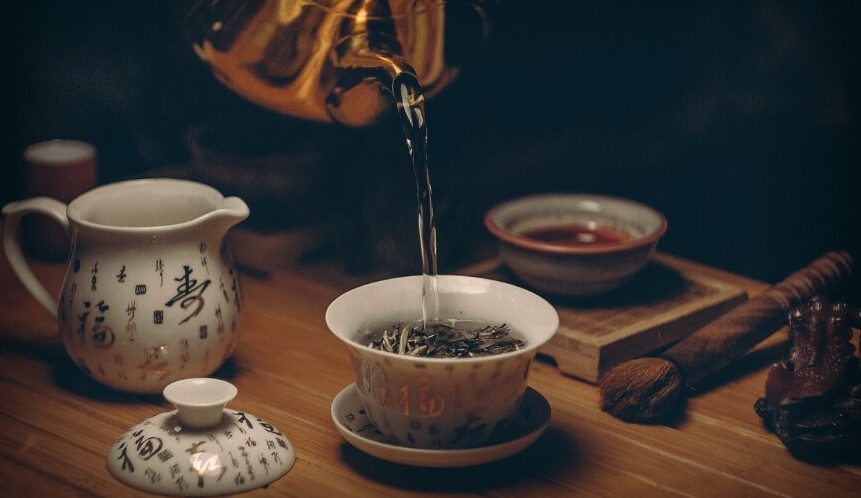
At first glance, green tea and martial arts might seem worlds apart—one a quiet ritual of reflection, the other a dynamic display of power. But in the heart of East Asia, they’ve long grown side by side, nourishing one another like bamboo and the earth it springs from.
Just as bamboo bends with the wind yet stands firm in the storm, both tea and martial arts teach a balance between strength and stillness, between action and mindfulness.
In my previous post on Green Tea and Kung Fu Panda, I explored a fun, animated take on this idea. This time, we’re going deeper—into temples and training halls, into the quiet strength of Shaolin monks and the focused grace of samurai.
As someone who practiced Kung Fu for several years (and never felt more in balance), I’ve always been drawn to how martial discipline and tea rituals both shape the body and still the mind.
So, let’s journey from the teahouse to the dojo and explore how green tea quietly fueled the way of the warrior.
The Monks Who Moved: Green Tea and Shaolin Discipline
High in the Song Mountains of China sits the Shaolin Monastery—birthplace of Chinese Kung Fu and a place where movement and stillness existed in harmony. Meditation was a central part of daily life there, requiring deep focus and clarity of mind.
That’s where green tea came in. Specifically, Dragon Well (Longjing) tea—a smooth, nutty, calming green tea that helped monks stay alert during seated meditation without bouncing off the stone walls. Think of it as the original pre-meditation drink, centuries before matcha lattes hit Instagram.
Monks would drink tea before and after kung fu practice, using it to calm the body and sharpen the mind. Brewing it became a ritual of its own—precise, respectful, meditative. Just like their forms. Just like their breath.
A Day in the Life of a Shaolin Monk
Tea wasn’t just a beverage; it was a practice in itself. Here’s what a typical day at the monastery might look like:
- 4:30 AM – Wake-up Bell: Monks begin with silent meditation and breathing exercises.
- 5:30 AM – Morning Tea: A light infusion of Dragon Well to awaken the senses without overstimulation.
- 6:00 AM – Martial Arts Practice: Kung Fu drills, forms, and weapon training.
- 8:00 AM – Breakfast and Chanting: Followed by group recitations and temple duties.
- 10:00 AM – Qigong & Meditation: Energy-balancing exercises supported by hydration and tea.
- 12:00 PM – Lunch and Reflection: Simple vegetarian meals, often followed by more tea.
- Afternoon – Study, Tea, and Additional Practice: Textual study or more kung fu.
- Evening – Tea & Evening Chanting: The day winds down with tea for digestion and calm.
In Daoist and Buddhist traditions, tea was believed to balance qi (life energy) and aid digestion and mental clarity—vital for long hours of both movement and meditation.
Some monks even used specific tea types for different parts of their routine: a brisker tea before martial drills, and a softer infusion after meditation.
The link between green tea and qi cultivation was particularly notable in qigong, a movement and breathing practice integrated into Shaolin training. Drinking tea became part of a cycle—move, breathe, sip, reflect. A fluid ritual of internal balance and external form.
Legend has it that Bodhidharma, the Indian monk who brought Zen Buddhism to China, cut off his eyelids to stay awake in meditation—where they fell, the first tea plants sprouted.
While the story might be more myth than fact, it shows just how closely tea and mindfulness were woven into the monks’ way of life.

The Warrior’s Calm: Green Tea and the Way of the Samurai
Meanwhile in Japan, a different kind of warrior was cultivating discipline, loyalty, and a seriously intense relationship with powdered tea.
The samurai didn’t just train with swords—they practiced chanoyu, the Japanese tea ceremony. At first glance, whisking a bowl of matcha might not seem as fierce as mastering the katana, but both required patience, control, and absolute presence.
Matcha, the vibrant, powdered green tea used in these ceremonies, was favored for its strong yet clean energy. The act of preparing and drinking it was about more than thirst—it was training for the mind. Every whisk, every bow, every sip reinforced the values of mindfulness, humility, and grace.
On quieter days, many samurai turned to Sencha, a more casual, refreshing green tea that was perfect for moments of peaceful reflection—or for sitting by the window watching the cherry blossoms fall (with only mild existential angst).
Modern Warriors: Green Tea and Contemporary Martial Arts
Fast forward to today—and you’ll still find green tea quietly powering the lives of modern martial artists. From dojos in California to Tai Chi parks in Hong Kong, green tea remains a trusted companion for practitioners seeking clarity, focus, and recovery.
Many athletes today, including MMA fighters, BJJ practitioners, and Tai Chi enthusiasts, incorporate green tea into their training routines. Its antioxidants aid recovery. Its caffeine content provides a gentle, sustained energy boost without the crash.
And for those following traditional disciplines, tea helps bridge the gap between old wisdom and modern living.
Contemporary martial arts studios often embrace tea as part of their wellness culture. Some offer tea ceremonies before class, while others stock chilled matcha for post-training cool-downs. Even virtual martial arts classes sometimes end with a shared tea ritual via Zoom.
The Balance Between Force and Stillness
Green tea and martial arts might live at different paces, but they teach the same lessons:
discipline, breath, control, and grace under pressure.
They’re both deeply physical and deeply spiritual. And maybe that’s why they’ve lasted so long—not just as traditions, but as practices.
As someone who’s sweated through more than a few Kung Fu drills (and limped home afterward), I found green tea to be the perfect follow-up.
It calms the nerves. It resets the breath. It reminds you to take things one step—or one steep—at a time.
Whether you’re landing a punch or steeping a cup, both call for presence and respect.

Personal Reflection (for modern life)
Even though we’re far from the Shaolin temples, we can still bring a little of that rhythm into our daily lives. A short morning meditation. A mindful cup of tea before jumping into work. A deep breath between emails. These small rituals help ground us, just like they’ve done for monks throughout the ages.
In a world that never seems to slow down, these little moments of stillness—tied to ancient traditions—can totally change how we approach our day. They remind us to take a pause, reset, and find a bit of balance in all the chaos.
Conclusion: Drinking with Intention, Moving with Grace
These days, most of us aren’t preparing for battle (unless you count your inbox). But the beauty of these traditions is that they still speak to modern life.
Green Tea invites us to pause. Martial arts teach us to move with purpose. And in both, we find a way to center ourselves—whether we’re walking into the dojo or just sitting quietly with a warm cup in hand.
Your Turn
Do you have a tea ritual or a movement practice that grounds you? Have you ever felt a bit monk-ish after a cup of Dragon Well, or maybe a bit samurai with your matcha whisk?
Join the conversation below – I’d love to hear how tea and movement intersect in your life. And yes, if you’ve ever tried Kung Fu after drinking too much matcha. I definitely want to know how that went.
